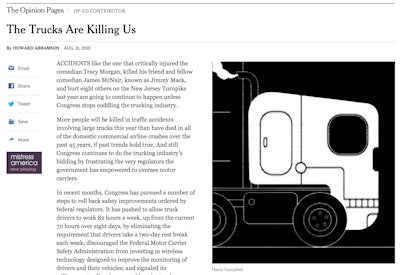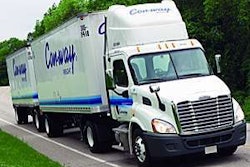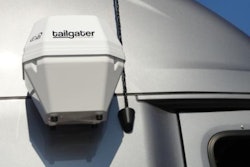
The column was written by former ATA executive Howard Abramson, whose main duties consisted of running Transport Topics magazine. Abramson wrote in the piece, which also included a cartoon cabover tractor as a skull, that Congress needs to “stop coddling” the trucking industry or highway safety will continue to be jeopardized.
ATA also announced Monday it sent a response letter to the New York Times, which the paper has not run yet, if it intends to.
The column, ATA writes, is riddled with debunked stats and talking points, along with statements that are “simply and totally wrong.”
For starters, ATA says, the NYT fails to differentiate between a truck-involved crash and a truck-caused crash, which implies “the trucking industry is responsible for all [the] deaths” in fatal crashes in which a truck is involved. “This simply isn’t true,” the group writes. “Per the most recent federal data available, upwards of two-thirds of all serious crashes involving large trucks are caused by the actions of someone other than the professional driver.”
Abramson’s points on hours-of-service rules also are “almost exactly the opposite” of what actually has occurred, ATA says. Abramson wrote that Congress last year removed the requirement that a driver “take a two-day break each week.”
In its response, ATA says “this isn’t just an implied falsehood — it is simply and totally wrong. What Congress has done…is [allow] drivers to take more than one two-day break each week should they need or want to…easing an onerous restriction that these breaks include two periods between 1 a.m. and 5 a.m.”
Other falsehoods in Abramsom’s column, says ATA, include: (a) the trucking industry is resistant to safety systems like airbags, stability control systems and anti-lock brakes and (b) trucks are disproportionately represented in crashes. DOT data “makes it clear,” ATA says, that “trucks are underrepresented in crashes” relative to the amount of miles driven.
“At the end of the day, there is no silver bullet, no magic gadget that will make roads entirely safe. But through education, by reducing crash risk through sound rules, safety technologies and tighter enforcement, we can continue the long-term improvements in truck and highway safety,” ATA writes. “Over the past decade, through the industry’s diligence and professionalism, as well as improvements in vehicle technology and enforcement, the number of truck-involved fatal crashes has fallen by a third.”
Click here to read ATA’s letter.












